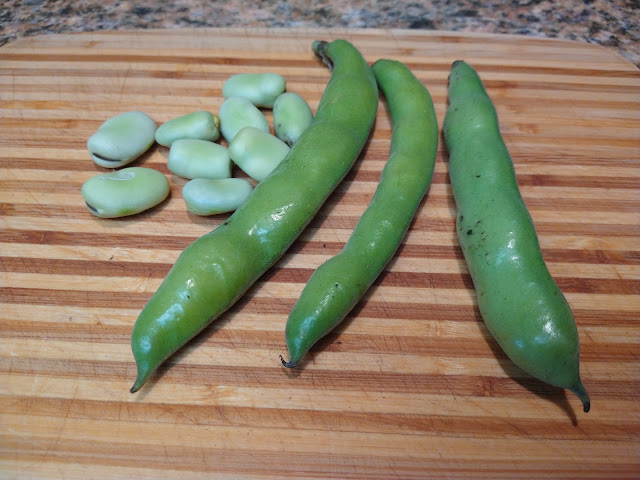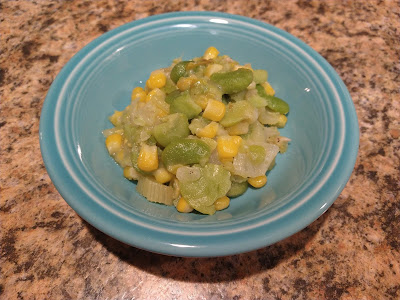
Recipe: Fava bean succotash with fresh corn
 |
| Favas have big pods and beans with chewy skins that are best removed. (Photos: Debbie Arrington) |
Succotash is a true American original. According to culinary lore, Native Americans introduced colonists to this mix of corn and beans – two crops that they grew (usually together). The name comes from an Algonquian word for “boiled corn kernels.”
In the late 1700s, New England recipes described succotash as “boiled corn and green beans especially limas.” Other vegetables were added to the flavorful mix and different beans substituted. Succotash evolved along with our country.
Favas work well as a substitute for limas, but these brightly colored (and meaty) beans cook in a fraction of the time. Although the peeled fava beans cook quickly, they take a while to prepare. After removal from their pods, large mature beans need to be individually skinned.
Those skins tend to be tough, chewy and bitter. Removal improves favas’ overall flavor and texture. Small, tender immature beans (under ¼ inch) can keep their skins on.
How to skin fava beans: Remove beans from pods. Bring a large pot of salted water to a boil. Plunge beans into boiling water and boil for 3 to 4 minutes, until the skins start to wrinkle.
Drain; plunge beans into ice water or rinse under cold water. With a thumb nail or paring knife, make a slit on long side of each bean and peel off skin, one at a time. Set aside the bright green fava beans.
Two cups unshelled fava beans yields about 1 to 1-1/4 cups peeled.
Fava beans also may be frozen for later use.
Fava bean succotash
Makes 4 servings
Ingredients:
1 cup fava beans, peeled
2 tablespoons butter
½ cup onions, chopped
½ cup celery, chopped including green tops
1 cup fresh corn kernels, cut from the cob
½ cup water
Salt and pepper to taste
Instructions:
Peel fava beans and set side.
In a heavy saucepan, melt butter. Saute onion and celery until soft.
Add corn kernels and water; bring to boil, then reduce heat to medium. Cover. Cook 4 minutes, until corn is almost tender.
Stir in fava beans gently. Add a little more water if necessary. Cover and cook over medium heat for 4 or 5 minutes, until beans are tender but not mushy.
Season with salt and pepper to taste. Serve immediately.
 |
| Fava bean succotash features fresh favas and corn. |
Comments
0 comments have been posted.Sacramento Digs Gardening to your inbox.
Sites We Like
Garden Checklist for week of Nov. 3
November still offers good weather for fall planting:
* If you haven't already, it's time to clean up the remains of summer. Pull faded annuals and vegetables. Prune dead or broken branches from trees.
* Now is the best time to plant most trees and shrubs. This gives them plenty of time for root development before spring growth. They also benefit from fall and winter rains.
* Set out cool-weather annuals such as pansies and snapdragons.
* Lettuce, cabbage and broccoli also can be planted now.
* Plant garlic and onions.
* Keep planting bulbs to spread out your spring bloom. Some possible suggestions: daffodils, crocuses, hyacinths, tulips, anemones and scillas.
* This is also a good time to seed wildflowers and plant such spring bloomers as sweet pea, sweet alyssum and bachelor buttons.
* Rake and compost leaves, but dispose of any diseased plant material. For example, if peach and nectarine trees showed signs of leaf curl this year, clean up under trees and dispose of those leaves instead of composting.
* Save dry stalks and seedpods from poppies and coneflowers for fall bouquets and holiday decorating.
* For holiday blooms indoors, plant paperwhite narcissus bulbs now. Fill a shallow bowl or dish with 2 inches of rocks or pebbles. Place bulbs in the dish with the root end nestled in the rocks. Add water until it just touches the bottom of the bulbs. Place the dish in a sunny window. Add water as needed.
* Give your azaleas, gardenias and camellias a boost with chelated iron.
* For larger blooms, pinch off some camellia buds.
* Prune non-flowering trees and shrubs while dormant.
* To help prevent leaf curl, apply a copper fungicide spray to peach and nectarine trees after they lose their leaves this month. Leaf curl, which shows up in the spring, is caused by a fungus that winters as spores on the limbs and around the tree in fallen leaves. Sprays are most effective now.